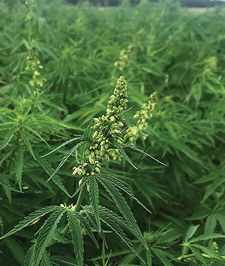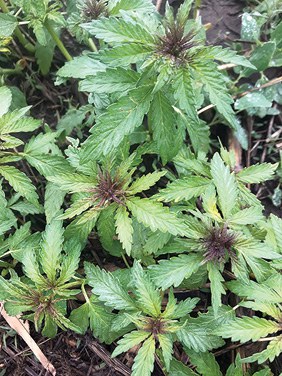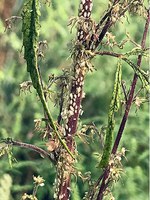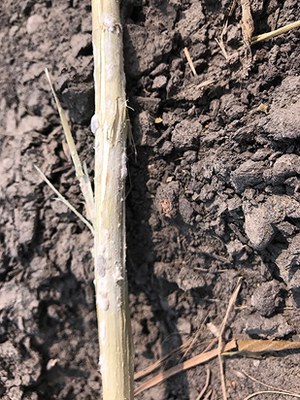Hemp for Grain Production in North Dakota
(A1950, March 2020)
Learn about hemp and how it can be used in grain production along with information about planting, fertility, weed control, as well as insects and disease.
Ryan Buetow, NDSU Extension Cropping Systems Specialist, Dickinson Research Exension Center
Lesley Lubenow, NDSU Extension Cropping Systems Specialist, Langdon Research Extension Center; Burton Johnson, NDSU Department of Plant Sciences Professor

Introduction to Hemp
Hemp (Cannabis sativa L.) yields many products derived from the seed, stem, leaves and flowers of female plants. Edible and industrial oils, dietary supplements and animal feed are derived from the seeds. Hemp stalks provide fiber used for paper, textiles, cloth and bio-composite plastics that are produced from the long, outer-stem bast fibers. The shorter, inner-stem hurd fiber is used for animal bedding, thermal insulation, particle board, hempcrete and other construction materials.
High cannabidiol (CBD) hemp varieties are marketed for remedial use. Plant hairs (trichomes) on leaves and female buds produce CBD. Epidiolex, a pharmaceutical derived from CBD, was registered by the Environmental Protection Agency in June 2018 for treatment of seizures associated with Lennox-Gastaut syndrome or Dravet syndrome in patients 2 years of age or older.
With many different uses for hemp, what is important to note is that agronomic management will differ depending on whether production is for grain, fiber, dual purpose (grain and fiber) or CBD production.
Agronomic research at North Dakota State University has focused on grain production since 2015 because this was the initial market for commercial in-state hemp production in 2016. In-state grain markets have been steady since 2016. Although hemp fiber has many uses and product development has advanced, the fiber industry is slow to develop because infrastructure associated with processing is largely lacking.
Fiber production from dual-purpose hemp cultivars primarily grown for grain may offer growers additional fiber revenue. Before considering growing hemp in North Dakota, we strongly recommend that you read through all needed information from the North Dakota Department of Agriculture.
Hemp is well-adapted for growing in North Dakota for grain production. As an emerging new crop, hemp has marketable potential in North Dakota.
Planting Conditions
Some issues to consider when planting hemp are germination rate and seedling mortality. A recommended plant population is 12 plants per square foot or 523,000 plants per acre. With germination rates generally ranging from 10% to 80%, seeding rates need to be adjusted accordingly.
Before planting, perform a ragdoll germination test with a moist paper towel at room temperature for six days to find germination percentage and adjust planting rates accordingly. Research suggests also adding an extra 25% to allow for seedling mortality.
A one-year study at the NDSU Langdon Research Extension Center compared three seeding dates of May 22, June 4 and June 18. The date of May 22 resulted in the highest grain yield of the three dates. Yields were reduced at June 4 and a large reduction in yield occurred with a final planting date of June 18. Stand density was lower at the June 18 date as well.
Hemp is susceptible to frost damage, so consider a planting timeline similar to soybeans for your region, and avoid planting into cool, wet soils. Hemp is not adapted for wet soils.
Take care in field selection to minimize drift concerns. Hemp is very sensitive to glyphosate drift.

|
Seeding Date |
Grain Yield |
Stand Density |
|
May 22 |
1,512 |
13 |
|
June 4 |
1,296 |
12.8 |
|
June 18 |
907 |
11.0 |
|
LSD (0.05) |
117 |
0.9 |
Fertility
NDSU has not tested fertility requirements for hemp. Hemp has been shown in Canadian studies to have a high response to nitrogen (N) fertilizer, with a recommendation for fertilizer similar to that of a high-yielding spring wheat.
Hemp seed may be sensitive to nitrogen placed near seed. Excessive or insufficient N has been linked to spikes in THC. Excessive nitrogen may delay maturity as well.
For potassium, phosphorus and sulfur recommendations, Manitoba Ag recommendations can be found at www.gov.mb.ca/agriculture/crops/production/hemp-production.html#fertili….
Weed Control
At this time, no herbicides are labeled for hemp. Weed management also includes cultural, mechanical and biological options.
As for cultural practices, by using delayed planting, you can manage early germinating weeds with a preplant or pre-emerge herbicide timing or with the use of tillage where applicable. By planting in reduced row spacing, the crop can canopy sooner to outcompete weeds during the season.
Hemp will not grow fast enough to outcompete weeds in Conservation Reserve Program-breakout situations where weeds are not fully controlled. Dry conditions will reduce hemp plant height and weeds, notably pigweeds, common lambsquarters and volunteer canola, will grow up in the plant canopy.
Insects and Disease
High numbers of aphids may be seen on hemp in August and September. We believe these are cannabis aphids. No insecticides are labeled for control. Natural predators such as ladybugs will travel into the fields to feed upon them.
Hemp seedlings may perish from damping off, Pythium spp. Seeing some plants succumb to this disease each spring is typical. Hemp plants will expand to fill in missing plant spaces. NDSU Langdon REC research shows yields could withstand a 40% stand reduction with no reduction in yield.
Hemp is susceptible to sclerotinia white mold in the stalks and in the grain heads. Proper crop rotation can assist in managing many potential disease and weed issues.


Current Research
Most of the work currently being conducted in the state is at the NDSU Langdon REC.
Starting in the 2019 growing season, work on hemp has been expanded to the Carrington, Dickinson and Hettinger RECs along with demonstrations and other hemp trials in Minot and Williston. Research is being performed on seeding date, seed treatments and variety trials along with other applied studies.
For more hemp information, visit:
■ www.gov.mb.ca/agriculture/crops/production/hemp-production.html
■ www.nd.gov/ndda/plant-industries/industrial-hemp
■ www.ag.ndsu.edu/langdonrec/crop-production-management
■ www.valleybio.com/userfiles/file/home/pdf/hemp_crop_description.pdf
■ www.hort.purdue.edu/newcrop/ncnu02/v5-284.html

 NDSU Extension does not endorse commercial products or companies even though reference may be made to tradenames, trademarks or service names.
NDSU Extension does not endorse commercial products or companies even though reference may be made to tradenames, trademarks or service names.
NDSU encourages you to use and share this content, but please do so under the conditions of our Creative Commons license. You may copy, distribute, transmit and adapt this work as long as you give full attribution, don’t use the work for commercial purposes and share your resulting work similarly. For more information, visit www.ag.ndsu.edu/agcomm/creative-commons.
For more information on this and other topics, see www.ndsu.edu/extension
County commissions, North Dakota State University and U.S. Department of Agriculture cooperating. NDSU does not discriminate in its programs and activities on the basis of age, color, gender expression/identity, genetic information, marital status, national origin, participation in lawful off-campus activity, physical or mental disability, pregnancy, public assistance status, race, religion, sex, sexual orientation, spousal relationship to current employee, or veteran status, as applicable. Direct inquiries to Vice Provost for Title IX/ADA Coordinator, Old Main 201, NDSU Main Campus,
701-231-7708, ndsu.eoaa@ndsu.edu. This publication will be made available in alternative formats for people with disabilities upon request, 701-231-7881.